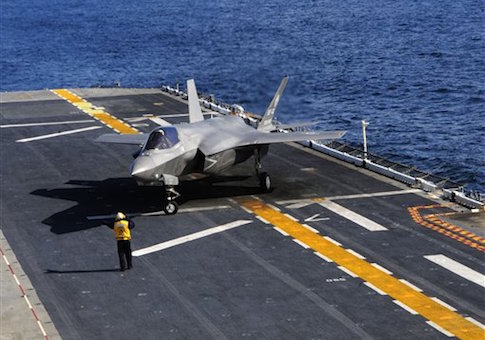The U.S. military is set to shutter 15 sites across Europe and reduce the number of active personnel stationed in these areas as the result of a wide-ranging restructuring that aims to consolidate some operations on the continent, the Pentagon announced Thursday.
The European restructuring is the culmination of a two-year consolidation plan known as the European Infrastructure Consolidation (EIC) and the changes will take effect in the coming years, according to the Pentagon.
The largest force withdrawal will take place across three UK-based bases. Fifteen sites in all will be returned by the United States to their host nations, the Pentagon told reporters on Thursday when announcing the finalized EIC plan, which is reminiscent of a previous decade-long realignment following the Cold War.
Germany, Italy, and Portugal also will be most impacted by the restructure. It is expected that local support staff at the bases will lose their jobs.
The Pentagon hopes to save around $500 million annually as a result of the wide-ranging restructure, which comes as the U.S. military battles against widespread budgetary cuts and growing international challenges across Europe and the Middle East.
While Pentagon officials have defended the realignment as necessary to cut costs, some critics say that the restructure may send a message of weakness at a time when nations such as Russia are increasing their rogue behaviors.
This latest realignment follows a series of significant reductions in Europe that have greatly reduced the U.S. military presence there.
"Approximately 1,200 U.S. military and civilian support positions will be eliminated, and about 6,000 more U.S. personnel will be relocated within Europe," John Conger, the acting assistant secretary of defense for energy, installations, and environment, was quoted as saying by the Defense Department.
"Up to 1,100 host-nation positions could also be eliminated and approximately 1,500 additional Europeans working for the U.S. could end up being impacted over the next several years, as many of their positions are relocated to areas we need to maintain for the long term," according to Conger, who managed the EIC plan.
Around 2,000 military personnel will be removed from the UK over the next years, while around 500 will be removed Azores Islands, a move that has sparked protest in Portugal, according to the BBC.
Defense Department officials maintain that the withdrawal and consolidation will not impact U.S. readiness or its ability to bolster allies in the region.
"We are consolidating and reducing some existing support infrastructure in order to be more efficient, but we are not affecting our operational capabilities," Derek Chollet, assistant secretary of defense for international security affairs, said on Thursday when announcing the widespread changes. "The EIC adjustments do not diminish our ability to meet our commitments to allies and partners."
However, insiders on Capitol Hill familiar with the shifts warned that the move is likely to embolden rogue leaders such as Russian President Vladimir Putin, who is counting on the U.S. military to continue its retreat from the region.
The restructure "sends a terrible message to NATO and Putin at a critical time," said one congressional staffer apprised of the changed. "Further, in a time when readiness is in the absolute pits—they are talking about spending $1.5 billion to close bases. Insane. What if we need to ramp up? What if Putin pushes further west? Or into the Baltics? What if we have to return forces to Europe?"
Outgoing Secretary of Defense Chuck Hagel argued that the reductions and movements would make the United States more nimble in the region.
"In the end, this transformation of our infrastructure will help maximize our military capabilities in Europe and help strengthen our important European partnerships so that we can best support our NATO allies and partners in the region," Hagel was quoted as saying by the DoD’s official press organ.
The most major divestment will be made at the U.K.’s Royal Air Force (RAF) Mildenhall base, which is being shut down. In turn, two squadrons of F-35 Lighting II joint strike fighter jets will move to the RAF Lakenheath facility in 2020, according information released by the DoD.
"The basing decisions will result in a net decrease of roughly 2,000 U.S. service members and civilians in the United Kingdom over the next several years," the Pentagon announced online. "About 3,200 U.S. personnel will relocate from RAF Mildenhall, and that will be offset by the addition of about 1,200 people who will be permanently assigned to the two F-35 squadrons slated to open at RAF Lakenheath."
Another "several hundred" U.S. military personnel will be moved to Germany in the coming years, while another 200 will go to Italy.
Mackenzie Eaglen, a former Pentagon official and defense expert at the American Enterprise Institute (AEI), said that the savings being touted by the Pentagon may not actually be reinvested in other theaters.
"On paper, the transfer of non-essential property back to host nations in order to free up funds for combat power and missions is usually smart," Eaglen explained. "However, combatant commanders don't own those funds and therefore the money will not automatically be returned to them for reinvestment elsewhere in theater."
"Any savings [European Command] reaps will go back to the black hole [Operations and Maintenance] account and be reassigned to another priority altogether and the European commanders will have no say in that regard," she explained.
There is also the risk that continued cuts will begin to impact readiness as potentially key logistics positions are eliminated, she said.
"Those on the front lines still left in Europe—like pilots—still need maintainers, engineers, and myriad other logistics support staff to keep them and their aircraft flying every day," she said. "While it's possible these positions are truly non-essential, Congress and the Pentagon have cut U.S. force structure much too deeply in Europe in their zeal to pivot elsewhere, save money, and stall a needed domestic base closure round."
